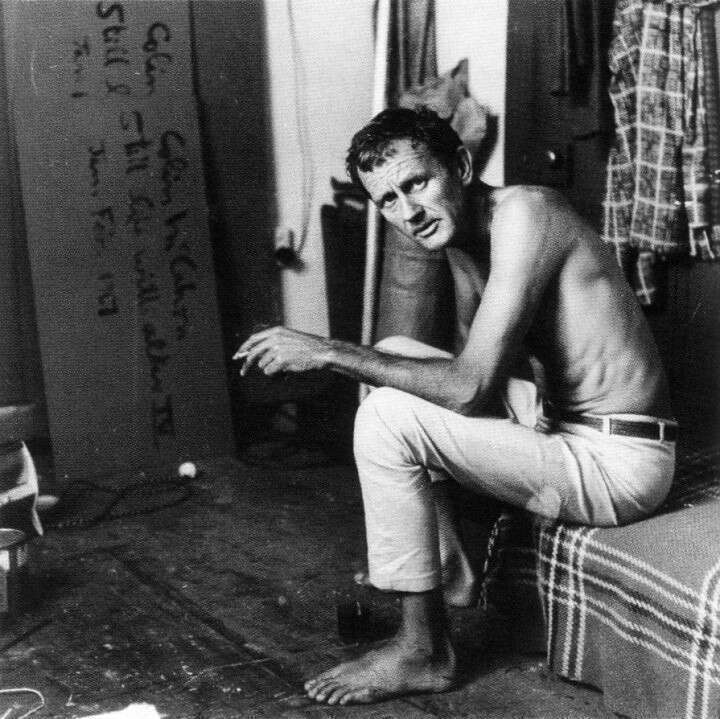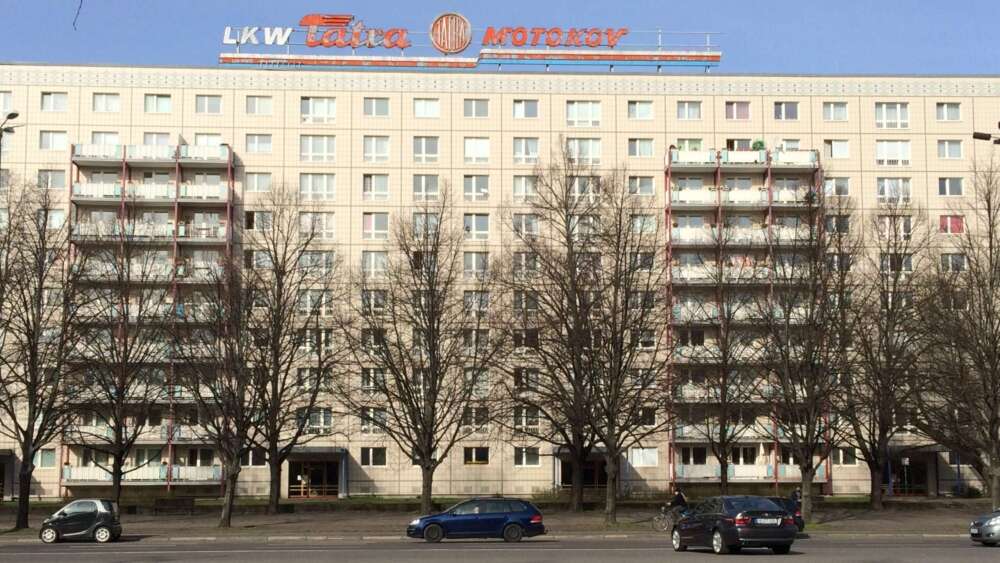1. Taking a walk
Walking down Karl Marx Allee in Berlin, you can sense the moment when Stalin died and the architects of the “German Democratic Republic” threw off wedding cake architecture and were liberated to build in the boxy international style. The street loses the classical columns and decoration that Moscow had decreed, becoming a series of white boxes on either side of a still-monumental avenue.
These were the apartments that the communist bureaucrats desired. Ironically, they closely resemble the prefabricated welfare housing that Sydney and Melbourne are embarrassed about.
For a Christian, it is tempting to see East Berlin as a metaphor for a society that did its best to squeeze God out of society. And to see the architecture of socialism as a symbol of the same.
Until one reflects that the West was ahead of the game in adopting the grids and egotism of the international style of architecture. Think of it this way, Park Avenue, New York City, came before Karl Marx Allee. It, too, is a monument to a God that is no god – capitalism – as opposed to communism. (But with George Orwell, if faced with a choice, one chooses the US, not the USSR.)
2. What Evangelicals tried to teach me
But the idea that the modernist aesthetic represents a departure from Christianity is deeply embedded in Evangelical Christianity.
The Book “Modern art and the Death of a Culture”, by Francis Schaeffer’s associate Hans Rookmaaker, unsettled me as an architecture student. For while I found Francis Schaeffer, who wrote about the intellectual movements of what is now the last century, helpful, I found Rookmaaker’s idea that Modernism should generally be rejected – and post-Modernism as well – unhelpful.
Rookmaaker sees modern art as a reaction against a technocratic world. “For many reasons, art has been assigned the role of the revelation of [an] existential, irrational order, which is above technocracy and apart from technology,” Rookmaaker wrote.
And in further describing the twentieth century, he writes: “Beneath the search for the absolute in much modern art, the desire to express what is ‘behind’ the oppressive appearance of a reality which is almost too naturalistic and too rational, there is an anxiety, a feeling of being lost, of death pervading all. Hence the desperate quest for the real, the positive which lies in the depths, behind, beyond this world. It is a quest for a mystical truth. But it is a truth without God, without any god at all.”
“Is Modernism a less-sympathetic art dialect to tell the Christian story?”
This analysis carries a mid-century sensibility. One could add that the emergence of desire, of eros as a motivator for art, also needs to be considered in critiquing Modernism – or most likely its post-Modern echo.
But we must ask: “Is Modernism a less-sympathetic art dialect to tell the Christian story?” Yes, figurative art suits narrative much better. But we’ll recount the story of an artist who did it well.
I was studying when post-Modernism was bursting through the doors of architecture. It came and went quickly, in front of its long march into cultural studies.
That “Modern Art and the Death of a Culture,” received the Evangelical equivalent of a Catholic imprimatur (an okay by a bishop) by being published by the “theologically correct” IVP press only made it worse.
3. Help from Aotearoa New Zealand
If you pick a good time to visit the National Gallery of Australia, you will spot “Victory Over Death 2” by New Zealand artist Colin McMahon. It is regarded as second in the collection only to Jackson Pollock’s “Blue Poles” by some critics. It is undoubtedly a second example of the NGA holding the leading masterwork by a great artist.
It was the gift of the NZ government to Australia when the two nations signed the CER (Closer Economic Relations) treaty.

Colin McCahon in 1960 James Joel
“Victory Over Death 2” is a more significant work with a more profound message.
While “Blue Poles” is an excellent modern painting that communicates joy or exuberance, at least to this observer, “Victory Over Death 2” is a more significant work with a more profound message.
The long thin painting begins in blackness on the left, with the giant letters “I AM” breaking out of the painting edge on the right, somewhat like a cross between an advertising billboard and an abstract expressionist painting. The “I” splits the image like something out of the New York School of painters McCahon would have encountered in 1958 when the Auckland City Art Gallery sent him on a sponsored trip. The “AM” interprets the mountains of New Zealand according to many writers in his work. Between and beyond the giant sans serif letters, the text of John 12 verses 27, 28, 29 and 25 in the New English Bible at the moment Jesus enters his passion.
This script is painted rhythmically. It is obvious where McCahon runs out of paint and fills his brush again. Perhaps this links to the action painting of Pollack.
4. McCahon and faith
Rex Butler and Laurence Simmons give a modernist twist on McCahon’s faith in their “Victory over death:the art of Colin McCahon”. They argue that the I AM in the Victory over death is ambiguous. They say the painting shows Christ lives on in the life of McCahon; the spectators of both the crucifixion itself and the picture are the resurrection in their view.
The “I” in “I AM” cuts across the Bible texts about the resurrection McCahon has painted. This idea leads Butler and Simmonds to state: “From left to right as our eyes jouney across it McCahon’s painting shifts from almost blank darkness to monumental “AM” and ends at the bottom right with the words ‘my way is known to you’.”
The I AM that overcomes death is Jesus.
In that reading of the painting, McCahon is seeking immortality, an afterlife, in his picture. An alternative view is that the I AM positioned as the painting reads from left to right is the means to journeying towards the light. The I AM that overcomes death is Jesus.
The orthodox interpretation of this picture is backed by it forming part of a series on resurrection painted by McCahon in 1969-70.
The title of another significant McCahon text-heavy work, “Practical Religion: the Resurrection of Lazarus showing Mount Martha,” hints at the painter saying the resurrection is the essence of practical religion and an answer for our world.
“Young Man, I Say to you Arise,” painted contemporaneously, shows the story of the widow of Nain who has her son restored to life.
In the NZ magazine Chrysalis Seed – a venture that supports Christian artists – Rob Yule puts these paintings in the context of the public attention generated by the NZ Presbyterian church holding a debate over the nature of the resurrection. “They are McCahon’s contribution to the debate, contemporaneous with the affirmation of Jesus’ resurrection by the Presbyterian Church and by two leading New Zealand theologians.”
(Lloyd Geering, the principal of Knox College Theological Hall, had questioned the physical resurrection of Jesus Christ and later said he did not believe in life after death. The Church dissociated itself from his views in 1970.)
Yule has a McCahon quote from this time: “I got onto reading the New English Bible and re-reading my favourite passages. I rediscovered good old Lazarus … one of the most beautiful and puzzling stories in the New Testament. … It hit me, BANG! at where I was: questions and answers, faith so simple and beautiful and doubts still pushing to somewhere else. It really got me down with joy and pain.”
5. Suffering with Christ.
In 1984, in Sydney for a retrospective exhibition, McCahon went missing in the Botanic Gardens and was found by the police in Centennial Park, kilometres away the next day. Reportedly he had no memory of where he had been. This episode became a novel, “Dark Night: Walking with McCahon” by Martin Edmond. It is described as “not a book written about McCahon, then, so much as one written beside him” by Justin Paton in the NZ Listener.
This dark night foreshadowed the dementia that shadowed McCahon’s last few years. These were years of painting with encroaching infirmity with his four last years beyond his art.
His infirmity was evident in one of his last series of paintings, “Paul to Hebrews” Yule describes. But still painting the Bible with a final quotation “BY thee, Lord, were earth’s foundations laid of old, and the heavens are the work of thy hands. They shall pass away; but thou endurest: like clothes, they shall all grow old; thou shalt fold them up like a cloak; yes, they shall be changed like any garment But thou art the same, and thy years shall have no end.” (Hebrews 1:10–12).
Yule comments in Chrysalis Seed, “If this be a ‘collapse of faith’, it shows how far secular society, with its shallow optimism, has moved from the realism of the biblical view of life, to which McCahon bore witness while his powers lasted.”
6. Walking with McCahon
McCahon’s resurrection paintings invite us to walk with him, to follow the I AM. There is indeed an invitation in the pictures to explore resurrection, not merely to admire a great artistic work. It is an invitation repeated every time the gospel story is told.
In this way, Butler and Simmonds are partly right when they say that McCahon intends to achieve an artistic afterlife “McCahon aims for his work to live on through its meditation on the afterlife of Christ, that he seeks to attain an artistic afterlife by identifying with that of Christ.”
They see this afterlife happening in each generation who comes to follow Christ on Earth.
But the eyes of faith will see the message of the paintings differently. “And if Christ has not been raised, your faith is futile; you are still in your sins. Then those also who have fallen asleep in Christ are lost,” writes Paul in 1 Corinthians 15. “If only for this life we have hope in Christ, we are to be pitied more than all men.”
If we were to be painters, would it (the resurrection) feature in our work?
If “Victory over Death 2” is McCahon’s most outstanding work, which seems to be the critical consensus, resurrection is at the centre of his life and oeuvre.
We need to consider whether it occupies the centre of ours. If we were to be painters, would it feature in our work? How would we make it work in the art movement of our time?
This column started with a walk down Karl Marx Allee, Berlin, a street of Modernism. We have considered the work of an artist who successfully integrated the era of modernist art and his faith. He is not the only one.
Karl Marx Alee points like an arrow towards the great TV tower at the centre of Alexanderplatz if we walk towards the city’s centre. It was intended as a symbol of the DDR by the master planners of East Berlin. The tower rises through an ornamental globe – it is a very sixties building full of self-importance. As the sun strikes the multifaceted sphere, a clear symbol that the DDR would never have wanted appears, picked out by the reflected sunlight. The cross.
As you gaze from Karl Marx Allee towards the tower, let’s bear in mind that any human aesthetic can take the Christian message – even those that struggle hard against the reality of a creation grounded in its creator.
Email This Story
Why not send this to a friend?



